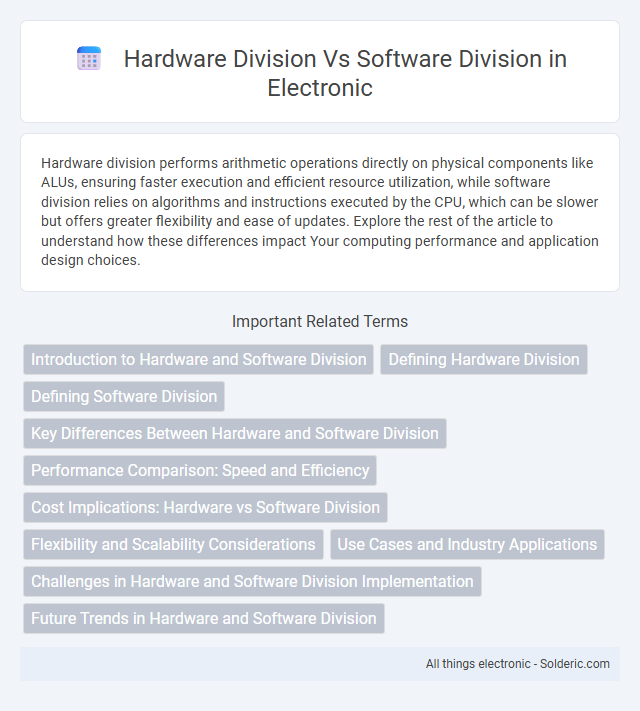Hardware division performs arithmetic operations directly on physical components like ALUs, ensuring faster execution and efficient resource utilization, while software division relies on algorithms and instructions executed by the CPU, which can be slower but offers greater flexibility and ease of updates. Explore the rest of the article to understand how these differences impact Your computing performance and application design choices.
Comparison Table
| Aspect | Hardware Division | Software Division |
|---|---|---|
| Primary Focus | Physical components and devices | Programs, applications, and code development |
| Output | Electronic gadgets, circuit boards, processors | Software applications, operating systems, middleware |
| Development Cycle | Longer, involving prototyping and manufacturing | Faster iterations, agile and continuous updates |
| Testing | Physical testing, compatibility with hardware | Automated testing, debugging, unit and integration tests |
| Skills Required | Electrical engineering, mechanical design, manufacturing | Coding, software engineering, system architecture |
| Cost Factors | High setup and production costs | Lower initial costs, higher ongoing maintenance |
| Scalability | Limited by physical resource constraints | Highly scalable via cloud and virtualization |
| Maintenance | Physical repairs and upgrades | Patch releases and version updates |
Introduction to Hardware and Software Division
Hardware division involves the physical components of a computer system such as processors, memory devices, and input/output peripherals, responsible for executing instructions and managing data flow. Software division refers to the collection of programs, operating systems, and applications that instruct hardware to perform specific tasks and provide user interfaces. Understanding the distinction between hardware and software divisions helps you optimize system performance and troubleshoot operational issues effectively.
Defining Hardware Division
Hardware division encompasses the physical components of a computing system, including processors, memory devices, input/output terminals, and storage units. It involves the design, development, and manufacturing of tangible electronic parts that enable computer operations. This division is critical for establishing the foundation upon which software programs execute and interact with the machine's physical architecture.
Defining Software Division
Software division refers to the specialized sector within a technology company responsible for developing, testing, and maintaining software applications, systems, and solutions. This division emphasizes coding, software architecture, user interface design, and continuous integration to deliver scalable and efficient digital products. Unlike hardware division, which focuses on physical components and devices, the software division prioritizes intangible code, algorithms, and user experience enhancements.
Key Differences Between Hardware and Software Division
Hardware division involves the physical components of a computer system such as processors, memory devices, and input-output equipment, designed for tangible infrastructure. Software division focuses on intangible elements like operating systems, applications, and programs that execute instructions on hardware. Understanding these key differences helps you optimize system performance and allocation of resources effectively.
Performance Comparison: Speed and Efficiency
Hardware division offers superior speed and efficiency compared to software division due to direct execution by the processor's arithmetic logic unit (ALU), minimizing latency and maximizing throughput. Software division relies on algorithms and multiple instruction cycles, resulting in slower performance and higher CPU usage. Your applications demanding real-time processing or high-frequency calculations benefit significantly from hardware-based division for optimized performance.
Cost Implications: Hardware vs Software Division
Hardware division incurs significant upfront costs due to expenses in manufacturing, materials, and physical assembly, whereas software division primarily involves development and maintenance expenses with lower initial capital investment. Your business must consider ongoing costs, as hardware requires inventory management and potential repairs, while software demands continuous updates and support. Evaluating these cost implications helps optimize budget allocation for product development and operational efficiency.
Flexibility and Scalability Considerations
The hardware division often faces limitations in flexibility and scalability due to fixed physical components and longer upgrade cycles, making rapid adaptations challenging. In contrast, the software division benefits from high flexibility through modular code design and seamless scalability enabled by cloud infrastructure and continuous deployment practices. Enterprises prioritizing agile response to market demands typically emphasize software scalability, while hardware scalability requires strategic planning and significant capital investment.
Use Cases and Industry Applications
Hardware division excels in industries requiring physical component manufacturing, such as automotive, aerospace, and consumer electronics, where tangible devices and machinery are essential. Software division dominates in sectors like finance, healthcare, and telecommunications, providing solutions through applications, data management, and automation to optimize processes and enhance user experience. Your business benefits from integrating both divisions to create comprehensive products, combining reliable hardware platforms with innovative software capabilities.
Challenges in Hardware and Software Division Implementation
Hardware division implementation faces challenges such as high production costs, long development cycles, and difficulties in scaling manufacturing processes. Software division struggles with rapid technology changes, maintaining code quality, and integrating diverse platforms and systems. Both divisions require effective resource management and coordination to ensure seamless product delivery and innovation.
Future Trends in Hardware and Software Division
Future trends in the hardware division emphasize advancements in quantum computing, energy-efficient processors, and edge computing devices designed to handle complex AI workloads locally. In contrast, software division trends focus on developing adaptive AI algorithms, cloud-native applications, and robust cybersecurity frameworks to improve scalability and security. Integration between hardware acceleration and software optimization is driving innovations in real-time data processing and immersive user experiences across industries.
Hardware division vs software division Infographic

 solderic.com
solderic.com